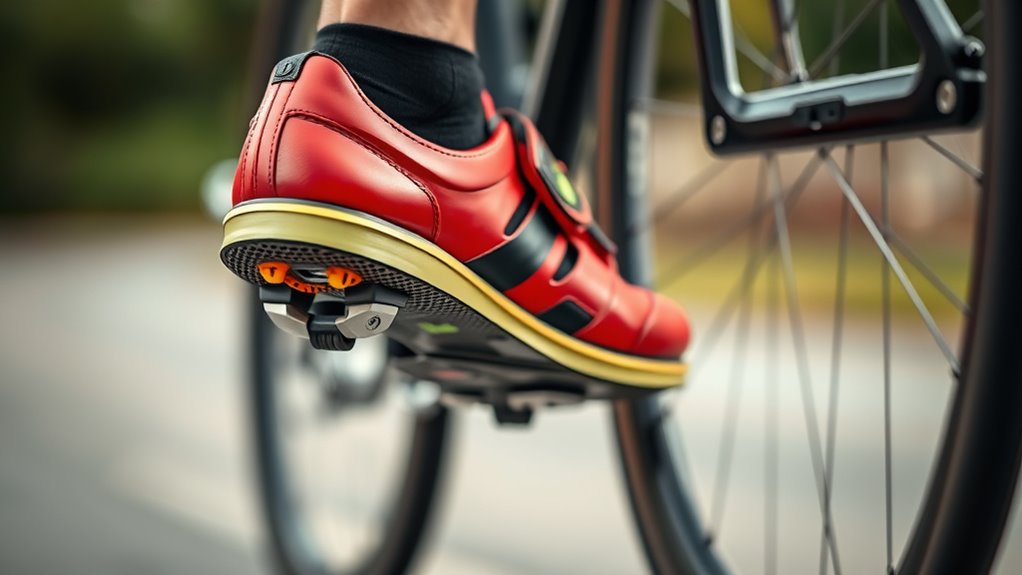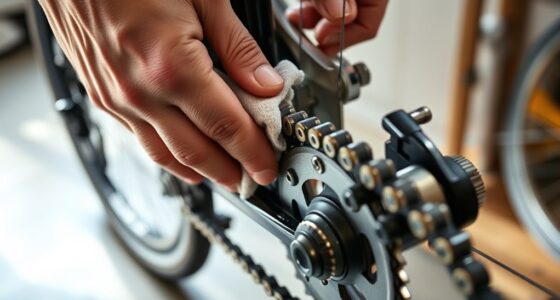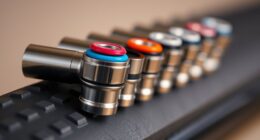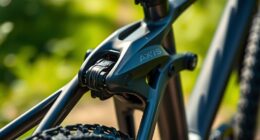To choose the right cycling shoes and cleats, start by evaluating your riding style, terrain, and personal preferences, then find shoes that fit well and suit your pedal system. Consider shoe stiffness, materials, ventilation, and compatibility with your bike’s pedals and cleats. Try them on later in the day and test their comfort with clips engaged. If you want to learn more about making the perfect choice, keep exploring the key factors involved.
Key Takeaways
- Match shoe stiffness and design to your riding style and terrain for optimal performance and comfort.
- Ensure proper fit by trying shoes at day’s end, considering foot width, arch, and overall comfort.
- Choose cleat and pedal systems compatible with your bike and riding needs, and adjust cleat position for knee alignment.
- Select shoes made from suitable materials with good ventilation or insulation based on climate and riding conditions.
- Test shoes with socks, walk around, and clip into pedals before purchase to confirm fit, stability, and cleat positioning.
Understanding Different Types of Cycling Shoes
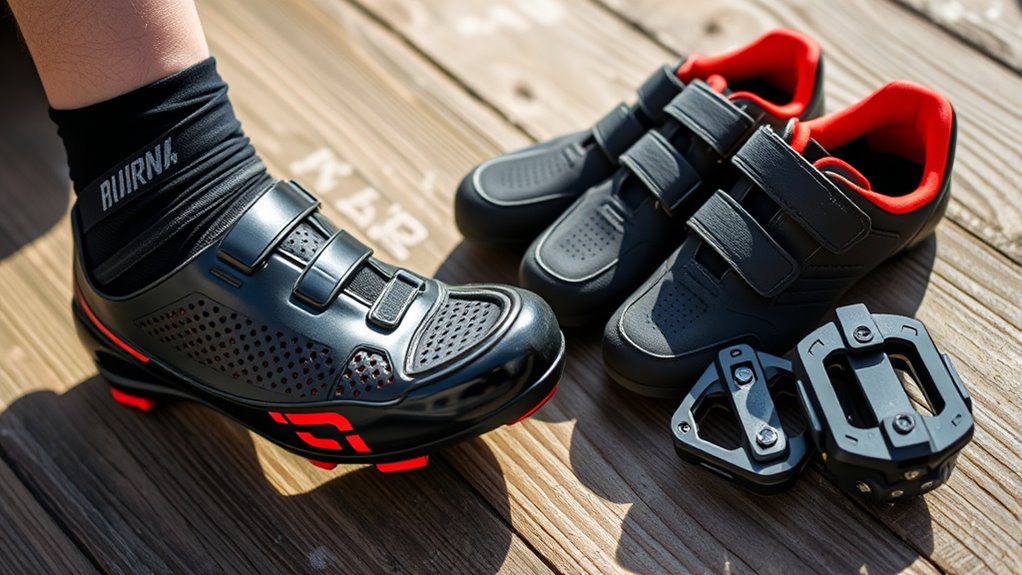
To choose the right cycling shoes, you first need to understand the different types available.
For mountain biking, you’ll want shoes with rugged soles and added grip, designed to handle rough terrain and provide stability. These shoes often feature clipless pedal compatibility for better power transfer and control on technical trails. Additionally, selecting shoes with appropriate sole stiffness can help optimize your pedaling efficiency and comfort on uneven surfaces. When selecting shoes, consider the Tuning aspects that can enhance your overall riding experience, such as fit and compatibility with your pedals.
If you’re into casual riding, comfort is key, so look for shoes with a relaxed fit, good ventilation, and easy-on/easy-off features. Casual riding shoes may not require specialized cleats, offering more flexibility and comfort for leisurely rides. Recognizing these differences helps you select footwear suited to your riding style and terrain.
Whether tackling rugged mountain trails or enjoying casual weekend rides, understanding your options ensures better performance and comfort. A proper fit is also crucial, as ill-fitting shoes can lead to discomfort and reduce your riding efficiency, regardless of the shoe type chosen.
Assessing Your Riding Style and Needs
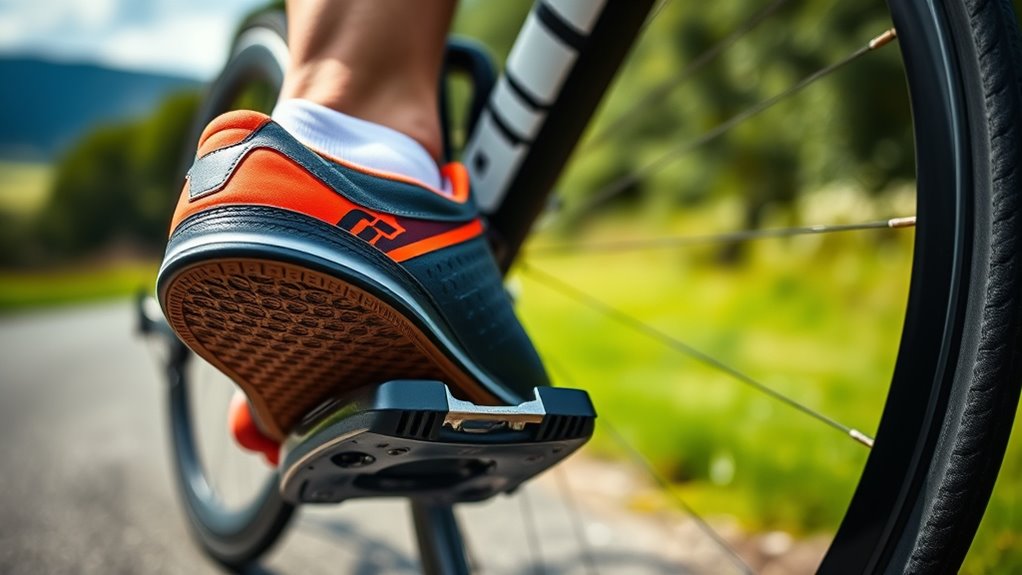
Understanding your riding style and needs is essential for choosing the right cycling shoes. Consider whether you primarily ride on roads, trails, or indoors, as this influences the shoe features you require.
Your riding style also affects cycling shoe aesthetics and shoe color coordination; for example, a sleek, minimalist look might suit competitive cyclists, while casual riders may prefer vibrant colors and designs.
Think about how often you ride and the type of terrain you encounter, as these factors impact shoe stiffness, ventilation, and weight.
Additionally, your choice may benefit from insights provided by 16PF traits, which help in understanding your personal preferences and behavioral tendencies related to cycling habits.
Ensuring Proper Fit and Comfort
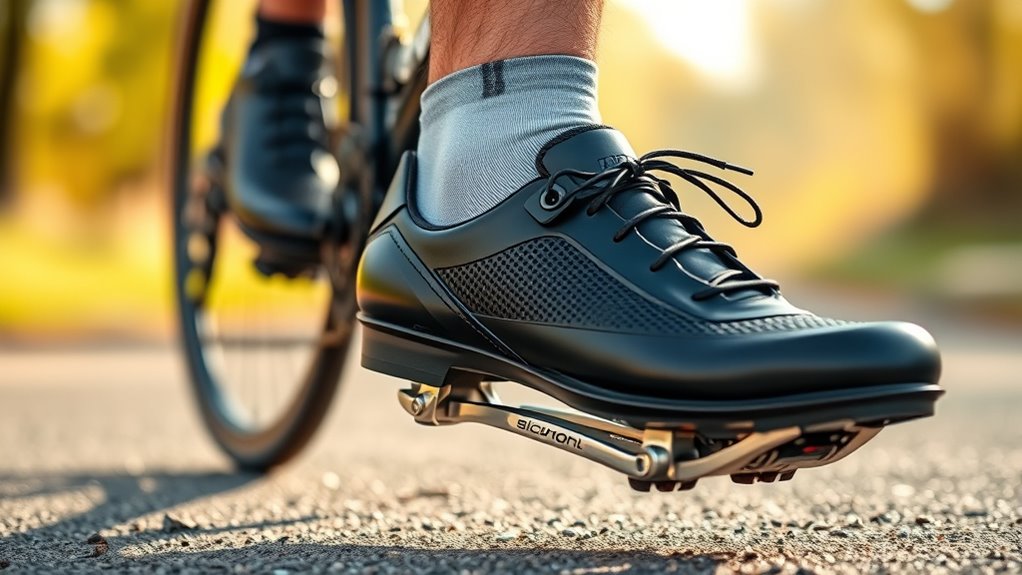
Ensuring proper fit and comfort is essential because ill-fitting cycling shoes can cause discomfort, reduce performance, and lead to blisters or injuries. Pay attention to your foot arch, as shoes that match your arch type provide better support and reduce fatigue. Proper shoe fit is crucial for avoiding foot issues and enhancing overall comfort during rides. If you have a high arch, look for shoes with added cushioning or arch support. If you have a low or flat arch, opt for shoes that offer stability and firm support. Shoe width is equally important—narrow shoes can pinch your feet, while too-wide shoes may cause slipping and blisters. Always try shoes on at the end of the day when your feet are most swollen, and ensure there’s enough toe space for comfort. Incorporating foot anatomy considerations into your choice can further improve comfort and performance. Understanding the horsepower of electric dirt bikes can help you select the right level of power for your riding style, ensuring an optimal balance between performance and comfort. Proper fit enhances your riding experience and helps prevent foot issues.
Compatibility With Your Bicycle and Pedals
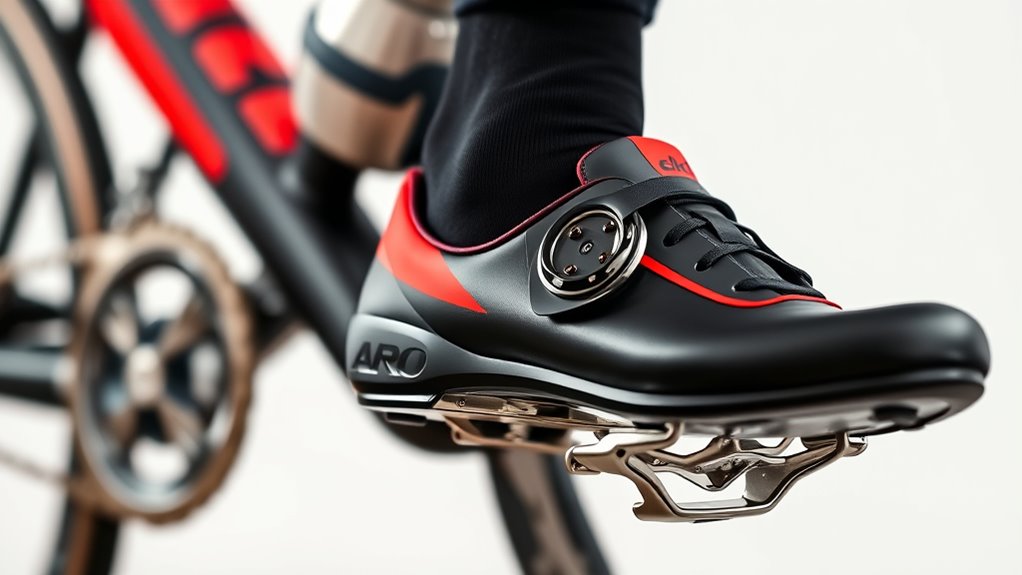
Matching your cycling shoes to your bicycle and pedals is essential for safe and efficient riding. Proper compatibility enhances pedal stroke efficiency and ensures a comfortable ride. Different pedal systems require specific cleats and shoe soles; mismatched components can reduce power transfer and cause discomfort. Before buying, check your bike’s pedal type and the cleat compatibility. Also, consider shoe sole stiffness, which influences power transfer and comfort. Selecting the right shoes also involves understanding how different sole designs impact overall performance and comfort. Additionally, knowing the pedal system compatibility can prevent issues with installation and use, ensuring a seamless riding experience. Being aware of the compatibility with tuning components can also help you choose shoes that are adaptable to future upgrades or modifications in your cycling setup. Moreover, understanding the variety of cleat types available can help you select the most suitable option for your riding style and preferences. Considering the availability of no-sugar-added brands for healthy hydration can also be beneficial if you plan extended rides and want to stay well-hydrated with healthier options.
Choosing the Right Cleat System
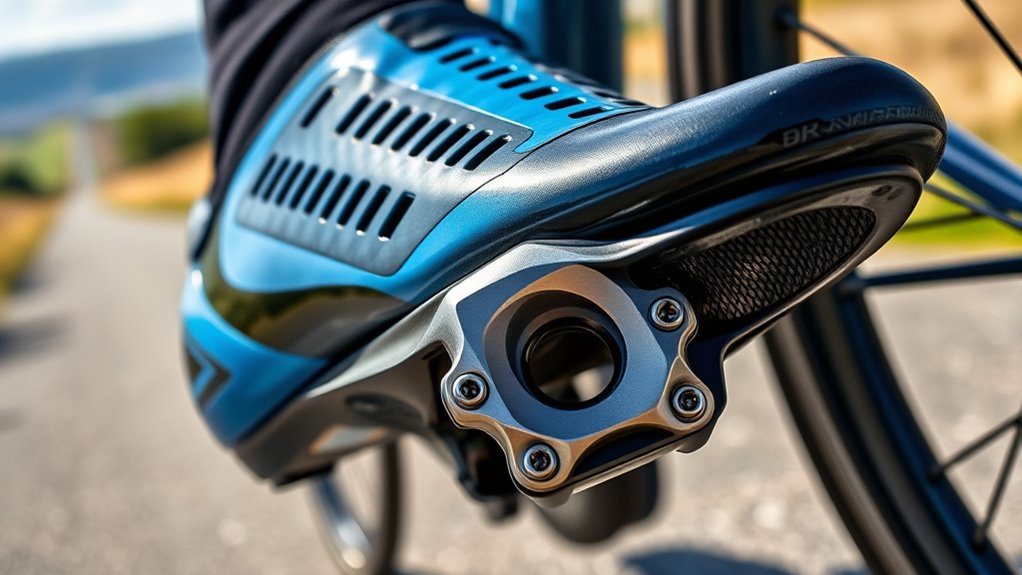
When selecting a cleat system, you need to think about how it will work with your pedals. Clipless systems offer a secure connection, while toe clips provide a more flexible option. Your choice depends on your riding style and pedal compatibility. For those interested in enhancing their bike’s performance, considering tuning options like custom modifications can improve overall riding experience. Additionally, understanding how projector technology impacts image quality can help you choose equipment that best fits your home theater setup. Exploring performance upgrades such as specialized shoes and cleats can also contribute to better power transfer and efficiency during rides. Evaluating the cycling shoe fit is crucial for comfort and efficiency, preventing foot fatigue on long rides. Furthermore, assessing the compatibility of your shoes and cleats with existing pedal systems ensures a seamless upgrade process.
Compatibility With Pedals
Choosing the right cleat system begins with understanding how it will work with your pedals. You need to verify pedal compatibility so your shoes and cleats fit your existing pedals or the system you plan to buy. Different pedal brands and models often require specific cleat types or mounting patterns. Check if your pedals support the cleat system you’re considering, whether it’s Shimano SPD, Look, or others. Additionally, consider shoe compatibility; not all shoes work with every cleat system. Make sure your shoe’s sole can accommodate the cleat mount and that the attachment mechanism aligns correctly. Vetted – Appliances Labs can provide insights into the best compatible options. Proper compatibility guarantees a secure connection, efficient power transfer, and ease of use, helping you maximize comfort and performance on your rides.
Clipless vs. Toe Clips
Deciding between clipless pedals and toe clips hinges on your riding style, comfort preferences, and experience level.
Clipless systems offer better footwear ergonomics by securely connecting your shoe to the pedal, improving power transfer and control. They’re ideal for serious cyclists seeking efficiency, but may require a learning curve. Additionally, performance tuning can further enhance your cycling efficiency when combined with the right pedal system.
Toe clips, on the other hand, are simpler, compatible with most shoes, and provide a classic aesthetic design. They’re suitable if you prefer quick foot release or ride casually.
Consider your comfort—clipless pedals can feel more integrated, while toe clips may feel more familiar. Your choice depends on whether you prioritize performance or ease of use.
Both systems can enhance your ride, but selecting the right one aligns with your biking goals and footwear ergonomics preferences. Additionally, understanding the Pimple Patch benefits can help you maintain healthy skin after long rides.
Making an informed decision involves understanding cycling shoe ergonomics and how it impacts your comfort and efficiency on the bike. For example, proper personal growth practices can help you develop the patience needed to master new cycling techniques.
Adjusting Cleat Position for Optimal Power and Comfort
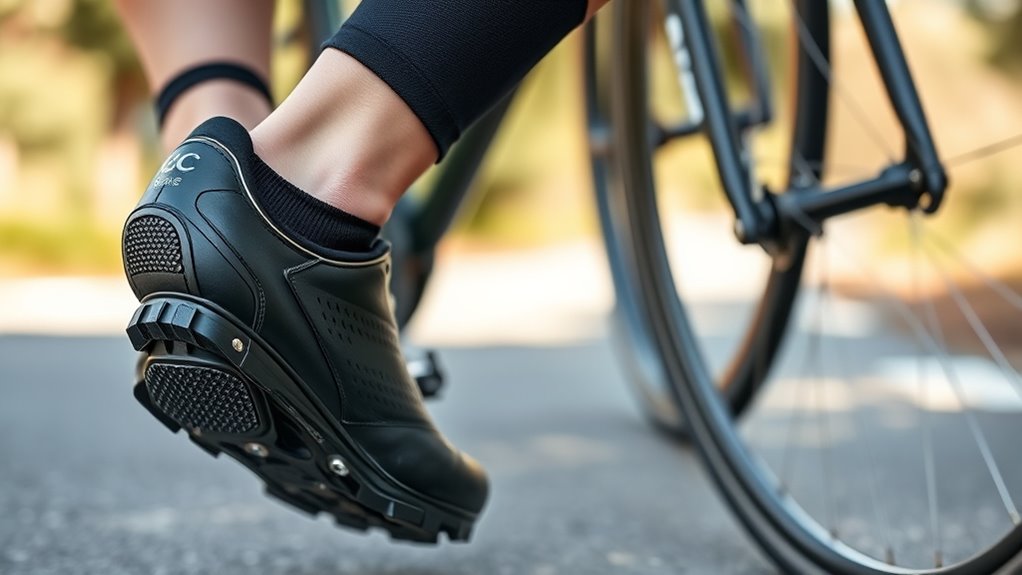
Proper cleat adjustment guarantees your knee stays aligned with your pedal stroke, reducing strain and injury.
You’ll want to fine-tune the fore-aft position to optimize power transfer without discomfort.
Making these precise adjustments improves pedal efficiency and keeps your ride smooth.
Alignment With Knee Joint
To guarantee your cycling shoes support a healthy and efficient pedal stroke, it’s crucial to align the cleats with your knee joint. Proper alignment reduces strain and improves power transfer.
Start by considering your ankle mobility, as limited ankle movement can affect cleat positioning. If you have high or low foot arches, adjust the cleats to accommodate your foot’s natural shape, ensuring even weight distribution.
Check that your knees track straight forward during pedaling; if they drift inward or outward, your cleat position may need fine-tuning. Be mindful that your foot position influences knee alignment, so take time to find the right setup.
Correct alignment promotes comfort, prevents injury, and maximizes your cycling efficiency.
Fore-Aft Positioning Accuracy
Adjusting the cleat’s fore-aft position is essential for optimizing power and comfort during your ride. Proper placement ensures your foot is aligned for efficient pedaling and reduces discomfort.
Start by evaluating your ankle flexibility; if you have limited flexibility, a slightly rearward position may feel more natural. Keep in mind that shoe aesthetics matter—adjusting the cleat won’t compromise how your shoes look.
To find the ideal spot:
- Position the cleat so the ball of your foot is over the pedal axle
- Move the cleat forward if you feel pressure on your toes
- Shift it backward if your heels feel too tight
- Test different positions on a short ride
- Consider your shoe’s aesthetic when making adjustments
Fine-tuning these factors helps you ride comfortably and efficiently.
Adjusting for Pedal Efficiency
Ensuring your cleats are positioned correctly can substantially boost your pedal efficiency and overall comfort. Proper adjustment maximizes power transfer, allowing you to use your energy more effectively with less fatigue.
Start by aligning the cleats so that the ball of your foot is directly over the pedal axle, which helps optimize pedal stroke. Fine-tune the angle to prevent strain on your knees and ankles.
Small shifts forward or backward can improve pedal efficiency by reducing unnecessary movement and increasing stability. Remember, everyone’s anatomy is different, so take time to experiment with minor adjustments.
Properly adjusted cleats ensure smoother pedaling, better power transfer, and increased comfort during long rides. Regularly check and refine your cleat position to maintain peak performance.
Selecting Materials and Construction for Durability and Weight
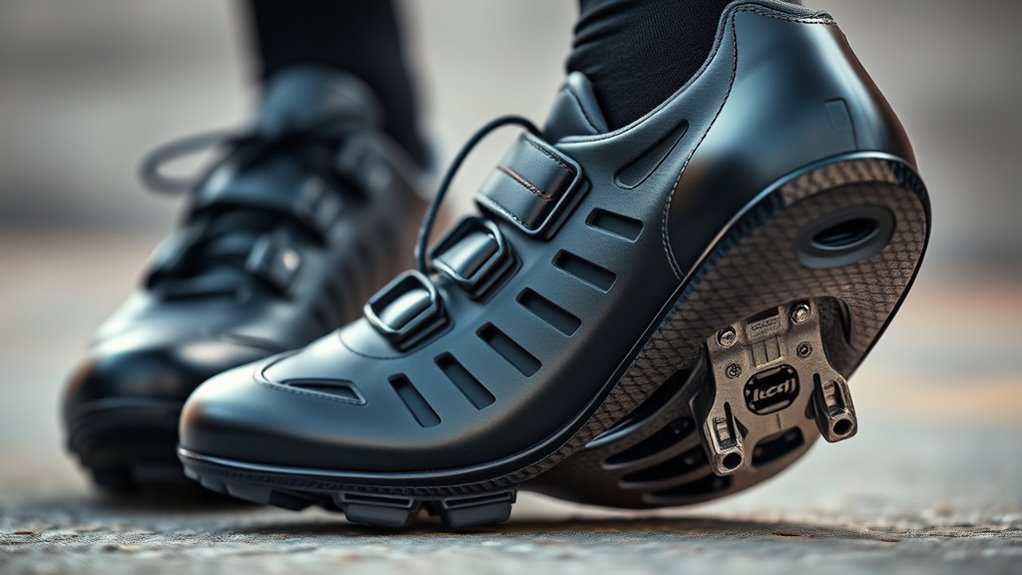
Choosing the right materials and construction methods is essential for balancing durability and weight in cycling shoes. Material types like synthetic leather, mesh, and carbon fiber offer different benefits.
Selecting the right materials and construction techniques balances durability with lightweight performance in cycling shoes.
Construction methods—such as molded or stitched designs—affect overall strength and flexibility. To optimize your choice, consider:
- Lightweight materials like carbon fiber for stiff, minimal weight shoes
- Durable synthetics that withstand wear and tear
- Reinforced areas for added longevity
- Seamless or minimal stitching to reduce weak points
- Advanced bonding techniques for a secure, lightweight build
Considering Ventilation and Climate Suitability
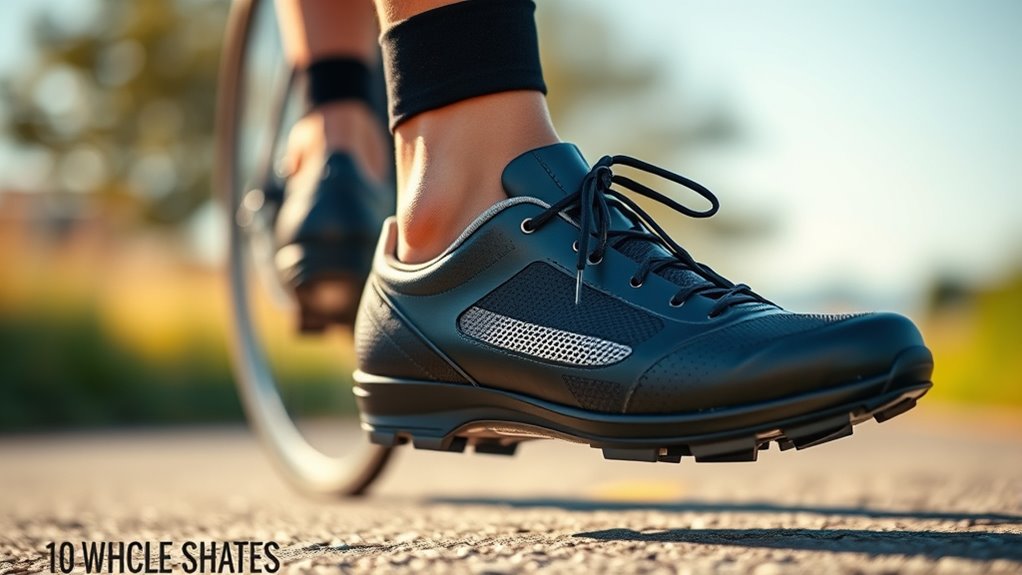
Selecting cycling shoes that match your riding environment is essential for comfort and performance. Ventilation and climate suitability directly impact breathability concerns, helping you stay comfortable during long rides or hot days. If you frequently ride in warm weather, look for shoes with mesh panels or breathable materials to promote airflow. For cooler seasons, consider shoes with insulation or water-resistant features to keep your feet warm and dry. Here’s a quick comparison:
| Season | Recommended Features |
|---|---|
| Summer | Mesh uppers, ventilation ports |
| Fall/Winter | Insulation, waterproof membranes |
| All-year | Breathable fabrics with weather-resistant overlays |
| Hot Climate | Lightweight, moisture-wicking materials |
Matching your shoes to the seasonal conditions ensures ideal ventilation and comfort.
Budgeting and Finding Value for Money
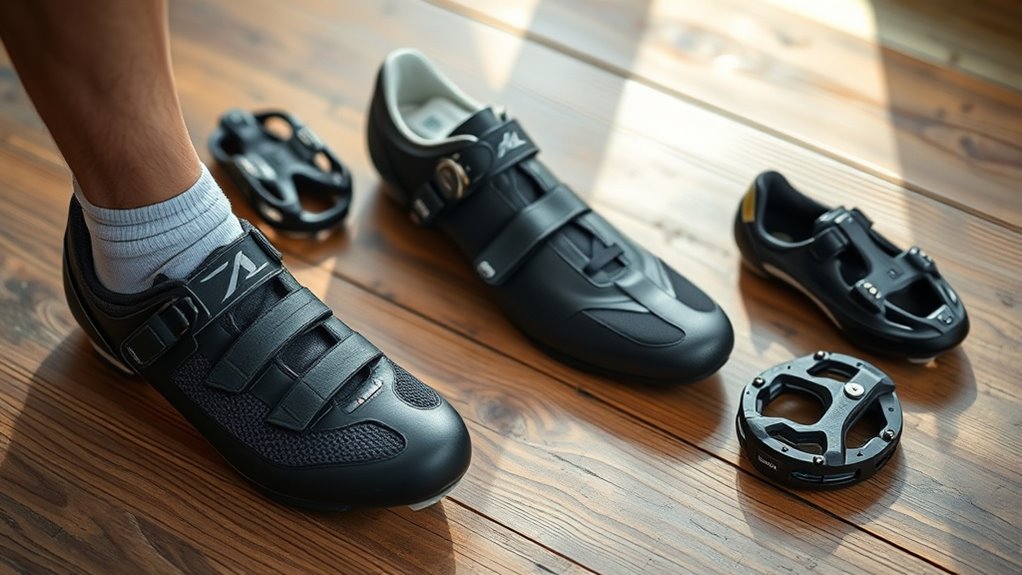
Finding cycling shoes that offer good value for your money doesn’t mean you have to sacrifice quality. Focus on the brand reputation to guarantee durability and performance, even if you’re on a budget.
Consider the color selection—some brands offer versatile options that match your bike and kit, giving you style without extra cost.
Look for sales or discounted models from reputable brands to maximize savings.
Keep in mind that cheaper shoes may lack features you need, so balance cost with functionality.
- Research trusted brands known for quality
- Choose neutral or versatile colors to extend style options
- Watch for seasonal sales and discounts
- Prioritize essential features over flashy extras
- Read reviews to gauge value and longevity
Tips for Trying and Buying Cycling Shoes and Cleats
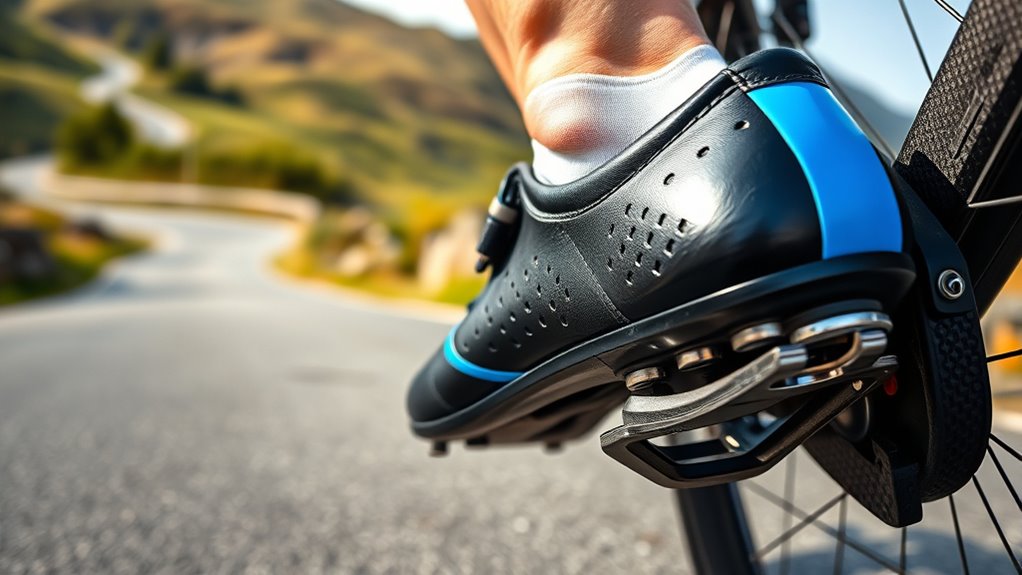
When trying on cycling shoes, make sure they fit snugly without pinching, and walk around to check for comfort.
Guarantee the shoes are compatible with your pedals to avoid issues later.
Before buying, test the shoes and cleats on your bike to confirm they provide the support and feel you need.
Proper Fit and Comfort
Making certain a proper fit is crucial for comfort and performance when choosing cycling shoes and cleats. You want shoes that feel snug but not tight, avoiding pinching or pressure points. When trying on shoes, consider these tips:
- Check the shoe aesthetic; it should match your style and motivation.
- Prioritize brands with a solid reputation for quality and durability.
- Ensure enough room in the toe box for slight movement without slipping.
- Test for comfort by cycling briefly in the shoes before buying.
- Remember that fit may vary between brands and models, so try multiple options.
A well-fitting shoe enhances your ride, boosts confidence, and reduces discomfort. Don’t compromise on fit for looks or brand name—comfort and proper fit are key.
Compatibility With Pedals
Choosing the right cycling shoes means making sure they’re compatible with your pedals and cleats, which is essential for efficient power transfer and safety. To guarantee proper compatibility, check the pedal type and cleat system your bike requires. Not all shoes fit all pedals, so understanding pedal compatibility is key. For example, some shoes are designed for SPD, while others suit Look or Shimano systems. Confirm that your shoes match your pedal’s cleat mounting system. Here’s a quick guide:
| Shoe Type | Pedal Compatibility | Cleat System |
|---|---|---|
| Road Shoes | Look, SPD-SL | Look, SPD-LH |
| MTB Shoes | SPD, SPD-SL | SPD, SPD-SL |
| Touring Shoes | SPD, SPD-SL, Look | SPD, Look |
Matching shoe compatibility with your pedals ensures a secure, efficient ride.
Testing Before Purchase
Ever wondered how to find the perfect fit for cycling shoes and cleats before making a purchase? Testing is key. First, try on shoes in the late afternoon when your feet are slightly swollen to ensure comfort. Walk around and clip into pedals if possible to check fit and mobility.
Pay attention to cycling shoe aesthetics—choose styles that suit your preferences. Consider the brand reputation; trusted brands often guarantee quality and durability.
When trying shoes, note these tips:
- Test with the socks you’ll ride in
- Check for even pressure across your foot
- Ensure sufficient cleat alignment
- Confirm that shoes don’t pinch or cause discomfort
- Walk and pedal to assess stability
This hands-on approach ensures you select cycling shoes and cleats that perform well and feel right.
Frequently Asked Questions
How Often Should I Replace My Cycling Shoes and Cleats?
You should replace your cycling shoes and cleats based on shoe longevity and cleat wear. Typically, shoes last about 500 to 1,000 miles, but check for cracks or worn-out soles.
Cleats usually need replacement after 300 to 500 miles, especially if you notice slipping or uneven clip engagement. Regularly inspect both to guarantee peak performance and safety, and replace them promptly when you see significant wear.
Can I Wear Road Cycling Shoes for Mountain Biking?
You can wear road cycling shoes for mountain biking, but keep in mind they’re not optimized for rugged terrain. Mountain biking shoes are designed for better grip and protection, while road cycling shoes prioritize efficiency on smooth surfaces.
Road cycling compatibility varies, so if you plan to ride mountain trails often, investing in mountain biking shoes offers better control and safety. For occasional rides, road shoes can work, but comfort may suffer.
Are There Specific Shoes for Different Weather Conditions?
Your cycling shoes are your trusty sidekicks, ready for any weather—like superheroes with weatherproof soles!
For different conditions, you should consider seasonal footwear that keeps your feet dry and comfortable. Weatherproof soles prevent water from seeping in during rain, while breathable materials help in hot weather.
Choosing shoes suited to the season guarantees you stay focused on your ride, no matter if it’s a scorching summer or a chilly winter day.
How Do I Prevent Blisters and Hot Spots?
To prevent blisters and hot spots, focus on sock selection by choosing moisture-wicking, seamless socks that reduce friction.
Use padding techniques, like adding cushioned insoles or gel pads, to create a comfortable fit and minimize pressure points.
Make sure your shoes fit well—neither too tight nor too loose—and tighten straps gradually during your ride.
Regularly check for signs of irritation and adjust your gear to stay comfortable on every ride.
What Are Signs That My Cleats Need Adjustment or Replacement?
When your cleats start feeling off, it’s time to take a closer look, as it’s often a sign they need adjustment or replacement.
Signs include uneven wear, persistent discomfort, or decreased pedal efficiency. Misaligned cleat alignment can cause knee pain or hot spots.
If you notice these issues, don’t ignore them—addressing cleat fit guarantees smoother rides and better power transfer, helping you stay on top of your game.
Conclusion
Choosing the right cycling shoes and cleats is like finding the perfect dance partner—each step should feel seamless and natural. By understanding your needs, prioritizing fit, and considering your riding style, you’ll set yourself up for a smooth ride. Think of your shoes as an extension of your bike, enhancing your performance and comfort. Trust your instincts, and soon you’ll glide effortlessly through every mile, your gear harmonizing with your passion for cycling.
